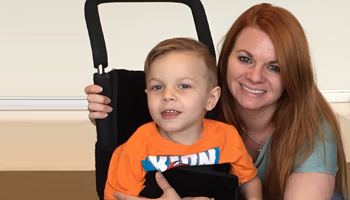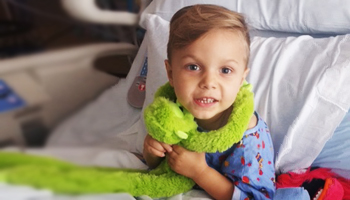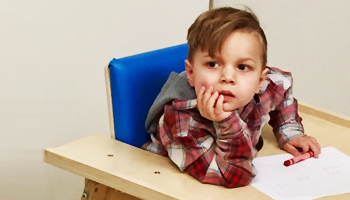HOW CAN WE HELP YOU? Call 1-800-TRY-CHOP
In This Section
Making Time for Science: Meet Jaxson and Megan, Research Hero and Super Mom
 By Nancy McCann
By Nancy McCann
Editor’s Note: This occasional blog series features stories of CHOP research heroes who have participated in clinical research studies. Without the generosity and dedication of families, patients, and members of the public who take the time to be a part of research, many trials would not succeed.
The alarm rings annoyingly loud at 6:30 a.m. Megan Payne knows she must rise with that blaring beep, or else the day goes haywire. With five young children to monitor, mornings are a blur of making breakfasts, packing lunches, brushing hair, and searching for lost homework before four kids leave the house at different times to board different buses to attend different schools. Only her youngest, 3-year-old Jaxson, remains behind. Oh, and Megan works three jobs and is a college student studying Environmental Science. Whew.
“It’s all about routine,” Megan said. “I have a calendar on the door. I tell everybody, if you want to know what’s going on and where Mom is, you look at the calendar.”
And, of course, there’s no time to rest with a preschooler in the house. Jaxson oozes personality. With his expressive brown eyes and boyband haircut, he can captivate a crowd as he glides into a room in his self-propelled wheelchair. Jaxson has spinal muscular atrophy (SMA), a debilitating genetic disease that affects the motor nerve cells in the spinal cord, causing muscle wasting and weakness, eventually taking away the ability to walk, eat, and breathe. Neurodegenerative and progressive, it can be fatal. However, SMA does not affect a person’s cognitive skills — the ability to think, learn, and build relationships remains intact.
Searching for a Diagnosis
Although Megan had a normal delivery, she knew right from Jaxson’s birth that he was different from her other children. A mother’s intuition, perhaps, as none of Jaxson’s four older siblings inherited the disease. At about 7 months of age, Jaxson’s parents started noticing he wasn’t meeting developmental milestones. He had trouble holding his head up. He didn’t crawl. He never stood on his own.
“No leg or arm weight-bearing — ever,” Megan said. A common cold would turn into pneumonia, a week-long hospital stay, and a need for supplemental oxygen. “He was always in respiratory distress. It was scary,” she said.
After close to two years of testing and searching for a diagnosis elsewhere, when Jaxson’s parents noticed he wasn’t showing reflexes, they brought him to Children’s Hospital of Philadelphia for evaluation. A muscle ultrasound and genetic tests confirmed Jaxson’s neurologist’s, John Brandsema, MD, suspicions: SMA.
“I cried the whole way home,” Megan said. “I thought my child had just been given a death sentence.”
 There are four types of SMA — I, II, III, IV — which are based on age at onset and highest physical milestone achieved. Jaxson has type II. Children with type II develop symptoms after 6 months of age. They can sit, but cannot walk. They have difficulty breathing, swallowing, and chewing, as the muscles that aid these basic functions of life are also affected.
There are four types of SMA — I, II, III, IV — which are based on age at onset and highest physical milestone achieved. Jaxson has type II. Children with type II develop symptoms after 6 months of age. They can sit, but cannot walk. They have difficulty breathing, swallowing, and chewing, as the muscles that aid these basic functions of life are also affected.
“Life has become very chaotic since his diagnosis,” Megan said. “We are always on the move with doctor’s appointments and physical therapy here at CHOP. And then PT, occupational therapy, speech therapy, and tutoring at the house. Plus regular checkups every six months. My mom helps with babysitting, if I’m not home with Jaxson yet. I couldn’t do it without her.”
Megan poured herself into SMA research. With guidance and input from Dr. Brandsema, support groups, other SMA families, and CureSMA, she learned of an ongoing gene therapy trial being conducted by a drug manufacturer, and she enrolled Jaxson to participate in the first of a series of studies planned to find out if it this novel approach could one day be an effective SMA treatment.
Testing a Possible Gene Therapy
SMA is caused by a mutation in the survival motor neuron gene 1 (SMN1). In a healthy person, this gene produces a protein that is essential to the function of the nerves that control muscles. Without it, those nerve cells cannot work properly and eventually die, leading to debilitating and many times, fatal muscle weakness. This experimental gene therapy aims to deliver a fully functional human SMN gene into target motor neuron cells in order to increase the patient’s production of SMN protein to a sufficient level. The goal is to prevent further muscle degeneration in type II children.
Children’s Hospital is one of several sites participating in this early, small-scale phase 1 clinical study to assess safety and dosage of the therapy. At the present time, Jaxson is the first and only child enrolled in the study here at CHOP. Gihan Tennekoon, MBBS, MRCS, LCRP an attending neurologist at CHOP and professor of Neurology in the Perelman School of Medicine at the University of Pennsylvania, is the primary investigator.
 Jaxson, our research hero, received the one-time treatment in September 2018 as a vector delivered via intrathecal administration — a lumbar puncture into the spinal fluid that surrounds the spinal cord and nerves. The procedure took only 20 minutes, and then Jaxson laid supine at a 30 degree incline with his feet elevated above his head for an additional 15 minutes to ensure the medication dispersed throughout his spinal column.
Jaxson, our research hero, received the one-time treatment in September 2018 as a vector delivered via intrathecal administration — a lumbar puncture into the spinal fluid that surrounds the spinal cord and nerves. The procedure took only 20 minutes, and then Jaxson laid supine at a 30 degree incline with his feet elevated above his head for an additional 15 minutes to ensure the medication dispersed throughout his spinal column.
“The stress was awful,” Megan said, “but it was done. He came through it fine. I was so relieved.”
Leaving the hospital after his four-day stay, Jaxson returns for follow-up visits: weekly at first, then bi-weekly, and now monthly. It’s a long day at CHOP for Jaxson and his mom, as a multidisciplinary team — PT, OT, pulmonary, cardiology, neurology, and a research study coordinator — cares for him. Jaxson, inevitably, finds a way to put a smile on their faces.
“Jaxson makes my morning,” chuckled Dr. Tennekoon, who will follow Jaxson’s progress and expects to complete data collection for the study by September 2020. “I think Jaxson’s a lovely kid. He’s smart; he’s a delight. He’s stubborn too; he does what he wants to do. And if he doesn’t want do anything, he takes his little wheelchair and gets out of the room.”
A Giving Community
Before Jaxson’s diagnosis, Megan admits she didn’t fully appreciate the sense of community shared by people with disabilities.
“Now I have a whole new respect for these parents and the love for their children with disabilities,” Megan said. “It’s astonishing. I found a strength in me that I didn’t even know was there. I have a whole new look on life. It’s changed everything. It’s made us big softies.”
Once Jaxson is in school full time, Megan plans to volunteer at a local hospital.
“I want to give back,” Megan said “I’ve never had this urge before. I see so many people giving. Like Jaxson’s power chair; someone gave it to us when they got a new one. That’s what this community does. Families of children with disabilities — they give.”
And so do you, Megan. Happy Mother’s Day.


